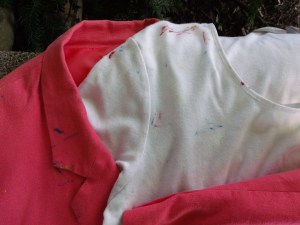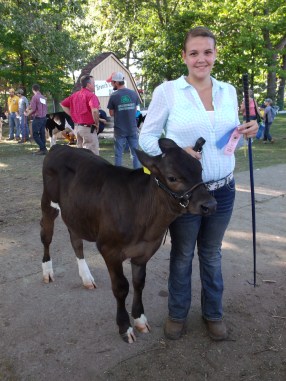As self-appointed Chief of the Frigidaire Police, I vigilantly patrol the area of my home laundry room, fearlessly ensuring the safety of the clothing that goes into and emerges from my washer and dryer.
Don’t let the phrase “laundry room” fool you into thinking I’ve got some kind of a big shot operation going. My laundry “room” is really just a very small, four-by-five-foot backside entryway to my home, seldom used since the house was built in 1875. Until some enterprising soul saw the utility of making it into a utility room around the time indoor plumbing arrived.

WINNING COMBINATION – Ajax, alcohol and elbow grease combined to take the dryer-induced crayon marks out of this T-shirt and jacket. Unfortunately, their owner was still stupid enough to throw the wet pair in the dryer together, which turned the cream-colored T-shirt peach. It’s going to stay that way.
After spending the first 10 years of adulthood being traumatized patronizing the frequent freakshow of Laundromats and the second decade traveling to the basement to fulfill my laundry fantasies, I’d had my fill of inconvenience. I became instantly grateful for the claustrophobic space off my kitchen that serves as the hub of my scrub-a-dub-dub with suds and duds.
One has to guard such convenience with tenacity, as the luxury of an easy access washer and dryer can easily turn into hardship when something slips by the attendant. Who among us, operating in the carelessness that follows on the heels of the complacency bred through repeated, mind-numbing routine, has not allowed something other than clothing to enter the washer and dryer?
I’m not talking small children or pets here, although both have surely happened. Rather, things forgotten in the pockets of our pants and minds. Like Asian carp seeking to enter the Great Lakes waterways, they swim their way stealthily through the environment, wreaking unnoticed havoc until it’s too late to prevent the damage.
From Kleenex, colorful tubes of chapstick, tiny earrings and motor damaging B.B.s and paper clip to assorted ephemera, including grocery lists, coupons, notes from school, receipts needed to redeem manufacturers’ rebates, social security cards and that perennial favorite, the payroll check, it all goes through and comes out in the wash. Just not in the same state it entered.
Although I theoretically aim high, my laundry standards ultimately remain low. Following Larry the Cable Guy’s mantra, “Git ‘er done” rather than Heloise hints for mint results, I choose speed over accuracy and shove white (anti-wedgie, naturally) underwear in with black backporch rugs, toss in some low-class laundry detergent and call it good. Or at least adequate. Hey, someone who washes underwear with rugs isn’t going to invest in a quality product like Tide, much less use the word “investment” in the same sentence as laundry.
On a good day, the fabrics that enter my washer and dryer come out better than they went in. Or at least with different problems. And change is good, right? At least that’s what they keep telling us at work.
My washing and drying operations are nothing if not metaphors for real life. Often there is opportunity to catch problems midway through the process, before they become devastating. In theory, vigilance could prevent permanent damage. The cap of a Sharpie marker can withstand a great deal of agitation and spin cycle, but it usually proves no match for the dryer’s tumbling pummeling.
But alas, time continues to work against me. In the spirit of haste, I blindly grab as large an armful of clothing as I can from the washer and stuff it directly into the dryer without further examination. My unexamined life problem manifests itself in my laundry room.
This week, dryer fluffing proved my undoing. I tossed a pair of capris from my drawer, a tee-shirt from the recently-laundered basket and a melon-colored linen jacket from my closet into the dryer with a damp cloth. I didn’t bother to inspect the pockets, as I assumed they were object-free.
A small, stupid box of crayons from the last time Kate and I breakfasted at Cracker Barrel were in the jacket pocket. I felt equally small and stupid while using Ajax for an hour to remove crayon from the cotton pants and shirt. I will use alcohol this weekend to work on the jacket. Should take about six ounces of something hard to get me in the right frame of mind to tackle the mess. Moral: Examine more closely your laundry and your life.

